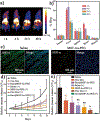A Catalase-Like Metal-Organic Framework Nanohybrid for O2 -Evolving Synergistic Chemoradiotherapy
- PMID: 31046176
- PMCID: PMC6690394
- DOI: 10.1002/anie.201902612
A Catalase-Like Metal-Organic Framework Nanohybrid for O2 -Evolving Synergistic Chemoradiotherapy
Abstract
Tumor hypoxia, the "Achilles' heel" of current cancer therapies, is indispensable to drug resistance and poor therapeutic outcomes especially for radiotherapy. Here we propose an in situ catalytic oxygenation strategy in tumor using porphyrinic metal-organic framework (MOF)-gold nanoparticles (AuNPs) nanohybrid as a therapeutic platform to achieve O2 -evolving chemoradiotherapy. The AuNPs decorated on the surface of MOF effectively stabilize the nanocomposite and serve as radiosensitizers, whereas the MOF scaffold acts as a container to encapsulate chemotherapeutic drug doxorubicin. In vitro and in vivo studies verify that the catalase-like nanohybrid significantly enhances the radiotherapy effect, alleviating tumor hypoxia and achieving synergistic anticancer efficacy. This hybrid nanomaterial remarkably suppresses the tumor growth with minimized systemic toxicity, opening new horizons for the next generation of theranostic nanomedicines.
Keywords: catalase-like activity; chemoradiation therapy; controlled drug release; radiosensitizer; tumour hypoxia.
© 2019 Wiley-VCH Verlag GmbH & Co. KGaA, Weinheim.
Conflict of interest statement
Conflict of interest
The authors declare no conflict of interest.
Figures




References
-
- Hosseini V, Mirrahimi M, Shakeri-Zadeh A, Koosha F, Ghalandari B, Maleki S, Komeili A, Kamrava SK, Photodiagn. Photodyn. Ther. 2018, 24, 129–135; - PubMed
- Song Z, Chang Y, Xie H, Yu X-F, Chu PK, Chen T, NPG Asia Mater. 2017, 9, e439.
Publication types
MeSH terms
Substances
Grants and funding
- FDCT 0109/2018/A3 /Macao Science and Technology Development Fund/International
- 21834004/National Natural Science Foundation of China/International
- ZIA EB000073/ImNIH/Intramural NIH HHS/United States
- ZIA EB000073/EB/NIBIB NIH HHS/United States
- 2018M640472/China Postdoctoral Science Foundation/International
LinkOut - more resources
Full Text Sources

